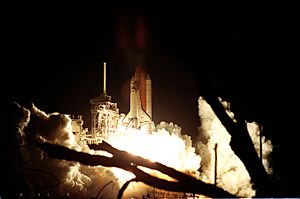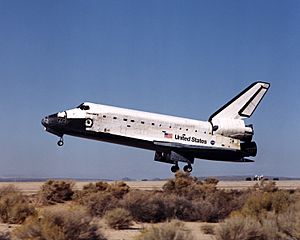STS-92 facts for kids
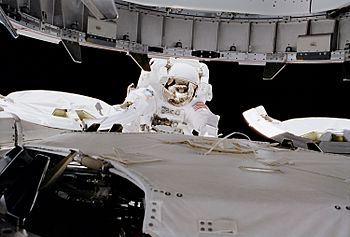
Wisoff oversees the Z1 truss (top) being mated with the zenith port of Unity (bottom) during EVA 2
|
|
| Mission type | ISS assembly |
|---|---|
| Operator | NASA |
| Mission duration | 12 days, 21 hours, 43 minutes, 47 seconds |
| Spacecraft properties | |
| Spacecraft | Space Shuttle Discovery |
| Launch mass | 115,127 kilograms (253,812 lb) |
| Landing mass | 92,741 kilograms (204,459 lb) |
| Payload mass | 9,513 kilograms (20,973 lb) |
| Crew | |
| Crew size | 7 |
| Members |
|
| Start of mission | |
| Launch date | 11 October 2000, 23:17:00 UTC |
| Launch site | Kennedy LC-39A |
| End of mission | |
| Landing date | 24 October 2000, 20:59:47 UTC |
| Landing site | Edwards, Runway 22 |
| Orbital parameters | |
| Reference system | Geocentric |
| Regime | Low Earth |
| Perigee | 386 kilometres (240 mi) |
| Apogee | 394 kilometres (245 mi) |
| Inclination | 51.60 degrees |
| Period | 92.3 min |
| Docking with ISS | |
| Docking port | PMA-2 (Unity forward) |
| Docking date | 13 October 2000, 17:45 UTC |
| Undocking date | 20 October 2000, 15:08 UTC |
| Time docked | 6 days, 21 hours, 23 minutes |
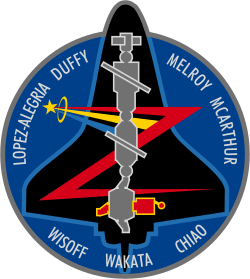 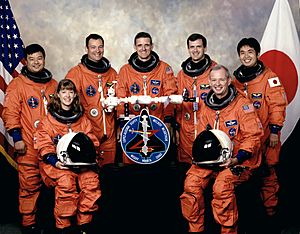 Left to right - Front: Melroy, Duffy; Back: Chiao, Lopez-Alegria, McArthur, Wisoff, Wakata |
|
STS-92 was an exciting Space Shuttle mission that helped build the International Space Station (ISS). The mission was flown by the Space Shuttle Discovery. It was a special flight because it was the 100th time a Space Shuttle had launched into space! STS-92 lifted off from the Kennedy Space Center in Florida on October 11, 2000.
Contents
Meet the Astronauts
The STS-92 mission had a crew of seven brave astronauts. They worked together to complete important tasks in space.
| Position | Astronaut | |
|---|---|---|
| Commander | Fourth and last spaceflight |
|
| Pilot | First spaceflight |
|
| Mission Specialist 1 | Second spaceflight |
|
| Mission Specialist 2 | Third spaceflight |
|
| Mission Specialist 3 | Fourth and last spaceflight |
|
| Mission Specialist 4 | Second spaceflight |
|
| Mission Specialist 5 | Third spaceflight |
|
Spacewalks: Working Outside the Station
During the mission, astronauts performed four spacewalks, also known as EVAs. These spacewalks were crucial for building the space station.
- Spacewalk 1
- Astronauts: Leroy Chiao and William S. McArthur
- Start: October 15, 2000 – 14:27 UTC
- End: October 15, 2000 – 20:55 UTC
- Duration: 6 hours, 28 minutes
- Spacewalk 2
- Astronauts: Michael López-Alegría and Peter J.K. Wisoff
- Start: October 16, 2000 – 14:15 UTC
- End: October 16, 2000 – 21:22 UTC
- Duration: 7 hours, 07 minutes
- Spacewalk 3
- Astronauts: Leroy Chiao and William S. McArthur
- Start: October 17, 2000 – 14:30 UTC
- End: October 17, 2000 – 21:18 UTC
- Duration: 6 hours, 48 minutes
- Spacewalk 4
- Astronauts: Michael López-Alegría and Peter J.K. Wisoff
- Start: October 18, 2000 – 15:00 UTC
- End: October 18, 2000 – 21:56 UTC
- Duration: 6 hours, 56 minutes
Mission Highlights: Building the ISS
STS-92 was a very important flight for building the International Space Station. The shuttle carried several key parts to the station. These included the Z1 truss, Control Moment Gyros, and a special docking port called PMA-3.
The Z1 truss was the first part of the station's outer framework. Think of it like the first big beam in a building. It allowed the first U.S. solar panels to be put on the Unity module. This gave the station early power. The Z1 truss also helped with communications.
The Control Moment Gyros (CMGs) are like giant spinning tops. They weigh about 27 kilograms (60 pounds) each. These gyros help the space station turn and stay in the correct position without using rocket fuel. The PMA-3 (Pressurized Mating Adapter-3) is a docking port. It allows other spacecraft, like the Space Shuttle, to connect to the station. It was also used for installing other parts later.
The mission involved seven days where the Space Shuttle was connected to the ISS. During this time, astronauts performed four spacewalks. They also had two chances to go inside the station.
Installing Key Structures
During the four spacewalks, two teams of astronauts worked together. They used a robotic arm to install the Z1 truss structure. This truss was placed on top of the Unity connecting node of the growing station. They also delivered the third Pressurized Mating Adapter (PMA-3) to the ISS. This adapter would be used for future parts of the station and for shuttle dockings.
The Z1 truss was the first permanent "backbone" structure for the ISS. It prepared the way for adding the station's much larger main trusses later on. The Z1 also held many parts for the station's communication system.
The Z1 truss contains four large gyroscopes called Control Moment Gyros (CMGs). These devices help control the space station's direction. They were activated after the U.S. laboratory module was installed.
Testing a Space Jetpack
During the fourth spacewalk, astronauts Wisoff and López-Alegría tested a special jet pack called SAFER. SAFER stands for "Simplified Aid For EVA Rescue." They flew up to 50 feet away from the shuttle while still being connected by a safety rope. This test helped make sure astronauts could move safely if they ever became separated from the spacecraft during a spacewalk.
See also
 In Spanish: STS-92 para niños
In Spanish: STS-92 para niños


